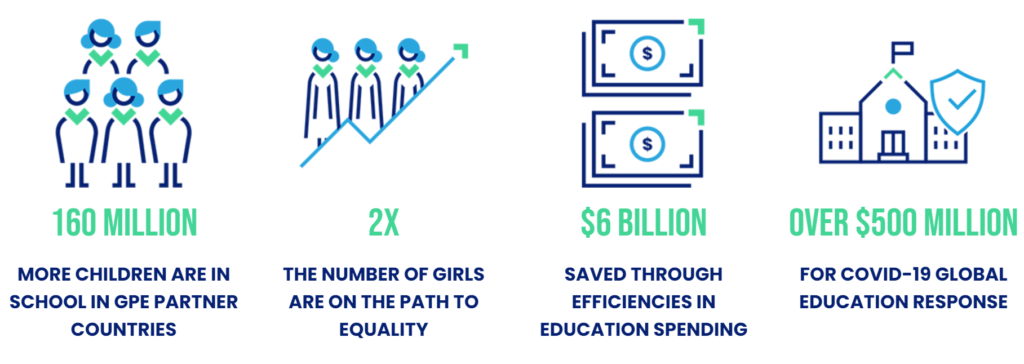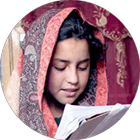The U.S. must raise its hand for global education with a bold $1 billion pledge.
Image: Barsha Kumari Pashawal in her (class five) classroom at Shree Ram Narayan Ayodhaya School, Pipra rural municipality, Mahottari District, Ward 4, Nepal. Credit: GPE / Kelley Lynch
The school day routine plays out daily around the globe — parents helping their kids get dressed, kids giving their parents one last hug before stepping out the door, and parents heading off for work.
When COVID-19 struck, this familiar schedule abruptly stopped. At one point, almost every child on the planet was out of school and every parent was left to figure out a new daily reality. For many, this marked a transition to online or hybrid learning. But for many other children facing poverty, isolation, or pushed to the margins, it has meant no school at all.
The education crisis brought on by COVID-19 threatens the historic progress made by communities globally to get millions more children in school. And the pandemic only worsens ongoing disparities in global education; decades of colonialism, resource extraction, and unjust global lending policies have created enormous barriers to education in dozens of lower-income countries.
Urgent action is needed now to ensure the current education crisis does not turn into a permanent catastrophe for an entire generation.
Countries themselves provide the overwhelming majority of education financing — with the Global Partnership for Education (GPE) bringing together international donors to fill key remaining gaps. As the only international fund of its kind, GPE has spent nearly 20 years helping governments invest in innovative solutions to get all girls and boys in school and learning. Its track record speaks for itself: Since 2002, 160 million more children have attended school with GPE support.
To build on this success, GPE and its partners have a bold plan to support up to 90 lower-income countries and territories in transforming their education systems. This summer, the governments of Kenya and the UK are bringing global leaders together to help fund this $5 billion plan.
With full funding from 2021-2025, GPE and its partners will support schooling for 175 million more children. Education is about both getting children into the classroom and making sure they can learn and learn well once they get there. GPE supports both. Ambitious funding will help ‘build back better’ from the pandemic and support communities to deliver quality learning for those who might otherwise be left behind.
The stakes have never been higher for the U.S. to show a new level of commitment on global education. At the GPE replenishment conference in July, we call on the White House to make a $US 1 billion five-year commitment. At this critical moment in global history, a bold pledge will show that the U.S. is committed to working hand-in-hand with the global community to ensure every child can achieve their dreams and reach their potential.

The value of a quality education
Quality education is the right of every child. When children can learn, and learn well, they have keys to a more just, prosperous, and equal future.
Evidence shows that quality education is linked to other broader social benefits — from poverty reduction to health improvements, gender equality, economic development, and more. For example, a girl with access to quality education can earn more income over her lifetime. She will be more likely to vote in elections. Her household is more likely to be healthier, with more nutritious food on the table and access to quality healthcare. And her children are more likely to go to school — paying the benefits of education forward to future generations.
Key point: Quality education is a human right with benefits that go far beyond learning. When children can learn, and learn well, they have keys to a more just, prosperous, and equal future.
The state of global education: The stakes have never been higher
The turn of the millennium ushered in an era of tremendous progress on global education. Many countries abolished school fees, invested in school infrastructure, trained teachers, and worked to improve gender equity.
The impact of this investment is clear: Throughout the 21st century, more children than ever before entered a classroom.
But this progress is under increasing threat from the COVID-19 pandemic, and continued gaps in education access and quality.
- COVID-19: Even the strongest education systems have reeled from the school closures, social disruptions, and economic losses wrought by the global pandemic. At its peak, the number of children out of school ballooned to 1.6 billion — about a six-fold increase from the start of the pandemic. And many more are at risk of falling behind or permanently stopping their education. Due to the pandemic, the number of out-of-school children could grow substantially for the first time in decades, while stretched national budgets could hinder education quality.
- Conflict: Even before the pandemic, more than 75 million children in crisis and conflict-affected countries needed support to access a good quality education. These children are twice as likely to be out of school compared with their peers in other countries.
- Entrenched global inequities and the legacy of colonialism: It’s no coincidence that the overwhelming majority of out-of-school children live in countries grappling with the lasting consequences of slavery and colonialism, as well as the ongoing extraction of natural resources by wealthier countries. Harmful structural adjustment policies mandated by global financing institutions in the 1980s also drive continued inequalities in education and other public goods.
- Unequal access: Even within countries, access and quality of education are still highly unequal. There is a major gap between school enrolment and completion rates among children in rural and urban areas, as well as among children in the lowest-income and highest-income households. And there is the gender gap, with girls completing school at lower rates than boys.
The stakes have clearly never been higher to get children in school. Yet evidence shows that even when children are present in the classroom, many are not receiving quality education. This learning poverty is an inequality starkly laid out in two parallel statistics: Nine out of 10 children in the world’s lowest-income countries cannot read a basic story by the age 10 — but the inverse is true in high-income countries, where 9 out of 10 children can. And many of the same drivers of inequity in access are driving inequity in education quality.
Key point: Progress on education is increasingly under threat from the COVID-19 pandemic, conflict, and longstanding global inequity in education access and quality.
The Global Partnership for Education: The right mechanism for this moment
Despite enormous challenges — from the COVID-19 pandemic, to the legacy of colonialism, to deepening inequalities — governments in lower-income countries are leading the way on education. They have prioritized the investments needed to help more children receive a quality education, and the global community should do more to back them up.
The Global Partnership for Education (GPE) is the only global partnership and fund dedicated solely to quality education in lower-income countries. For nearly 20 years, GPE has helped get more girls and boys in school and learning. Its partner countries are home to 82 percent of the world’s out of school children.
Why we believe the U.S. should support funding for GPE:
GPE has a strong track record of success. Since 2002, GPE has mobilized funding and partnerships to support countries to get 160 million more children in school — more than half of whom are girls. In GPE partner countries, primary enrollment for girls has more than doubled. And in almost three-quarters of partner countries, girls are completing school at equal rates as boys.
GPE is on the frontlines of the current education crisis. As the pandemic wreaks havoc on school systems around the world, GPE has mobilized its largest-ever emergency response — becoming the largest provider of education grants in the COVID-19 response. GPE has distributed $500 million to help partner countries reopen schools safely or enhance remote learning. As a result, 355 million children have been able to continue their education. GPE is also working in countries with the greatest need. In 2019, 76% of GPE funding went to countries affected by conflict and fragility.
GPE channels global funds to local-led strategies for education quality. Even in the lowest-income countries, education is overwhelmingly funded by national governments. Although GPE funding represents only a small proportion of national education budgets, it provides a critical boost to the discretionary financing available for governments to transform their education systems for the future. When existing government budgets are stretched by maintaining schools and paying teachers, GPE funding helps cover essential work to promote special needs and inclusive education, reach marginalized communities such as refugees, and create more culturally appropriate textbooks.
GPE shows the value of a multilateral and inclusive approach. National education groups — which not only include government officials, but also teachers, unions, and civil society — work together to develop and implement national plans for GPE funding. GPE’s approach isn’t one-size-fits-all: funding is driven by what communities want and need, and what’s proven to work. This approach ensures outside investments support strategies that work best in each specific context and can actually have a positive impact. And as a multilateral institution, GPE can respond to the specific needs and context of partner countries without national political constraints.
Key point: In this high-stakes moment for global education, GPE is the right mechanism for donors like the United States to play their part in transforming education.
Investing now to transform global education for the future
GPE must raise at least US$5 billion for 2021-2025 to fund country plans to transform education systems for more than 1 billion children. You can read the full investment case here.

With full funding, GPE can ‘build back better’ from the pandemic and support communities to deliver quality learning for the furthest behind. A $US 5 billion replenishment will boost the discretionary education spending of partner countries by nearly a third, enabling them to deliver quality education for more children and transform their education systems for the future.
GPE leverages both the power of partnership and catalytic funding to deliver impacts that go far beyond its direct investment. A fully-funded GPE from 2021-2025 will:
- Get 88 million more children into classrooms than would otherwise be possible.
- Enable 175 million girls and boys to learn.
- Reach 140 million students with professionally trained teachers.
- Save $16 billion through more efficient education spending.
- Leverage an additional $3 billion in donor funding through innovative financing tools.
From reduced poverty, to improved gender equality, to more peaceful and resilient communities, the ripple effects of a $US 5 billion investment in GPE will benefit communities for generations to come. GPE estimates that its investments over the next five years will add $164 billion to partner country economies, lift 18 million people out of poverty, and prevent 2 million girls from being forced into child marriage.
The cost of inaction if we do not meet this moment is high. Without the additional efforts and resources leveraged by GPE, partner countries will lose a vital opportunity to accelerate progress in learning. Thirty-three million children, half of them girls, could lose the chance to learn to read. And the COVID-19 crisis could become a permanent catastrophe for children’s education.

Afghanistan
“I would like to become a teacher one day and return to my hometown to enroll girls in school.”
– Wasilla (student)

Sierra Leone
“For the most part, we were able to have the best results that year. That was an indication that with the right teacher, in the proper setting, learning could take place and the quality would improve.”
– Michael Duff,
Education Radio Manager, Freetown

Nepal
“We thought, ‘Who will look after the children and the goats?’ We needed our daughter to stay home and help with the work around the house.”
– Barsha’s mother
Focus on: Girls’ education
Since 2002, GPE has supported partner countries to enroll an additional 82 million girls in school, including 39 million girls living through crises and conflict. In Afghanistan, for example, GPE supported recruitment, training, and support for women to become teachers, with girls’ enrollment steadily increasing in turn. And in several countries, GPE’s COVID-19 support is specifically focused on helping prevent gender-based violence during the pandemic.
The gender gap in global education is shrinking – primary enrollment rates for girls has more than doubled and, in many places, girls are increasingly completing school at equal rates as boys. But the COVID-19 pandemic is throwing this progress into question. Girls who are now out of school may have been forced into marriage or become pregnant or both – throwing up roadblocks for their return. With its next five-year plan, GPE estimates that it can reach 46 million girls and that 2 million girls will ultimately be kept out of child marriages.
What the U.S. can do: A bold $1 billion pledge
After years of pulling back and looking inward, the role of the U.S. in the global community is uncertain. President Biden must show the world that the U.S. is committed to working hand-in-hand with other countries to tackle our toughest collective challenges.
We know that education is the foundation of just, inclusive, and prosperous societies. Yet the U.S. has historically lagged in its contributions to GPE, falling well behind other donors with economies that are only a fraction of its size.
In June, President Biden will join other heads of state at the G7 Leaders’ Summit, where he should help make sure GPE is a shared top priority. The GPE replenishment summit will then take place on July 28-29, 2021, co-hosted by UK Prime Minister Boris Johnson and President of Kenya, Uhuru Kenyatta. The conference offers an opportunity to establish the U.S. as a leader in global education and to show the world that we are committed to working in partnership to create a better world for all.
The White House must come to the table with a $US 1 billion commitment over five years — a historic pledge that would double the country’s current support to GPE. At this perilous moment in our shared history, the U.S. must stand up as both leader and partner to secure the future of the world’s children.
**Unless otherwise linked, all data and statistics are from the GPE Case for Investment.
